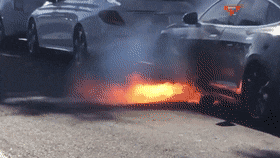Tesla burst into flames after sitting idle in a junkyard for three weeks
A dead white Tesla Model S was sitting in a Rancho Cordova, California junk yard earlier this month when it suddenly erupted in flames.
When firefighters arrived, the electric car was engulfed, according to the Sacramento Metropolitan Fire District. Every time the blaze was momentarily extinguished, the car’s battery compartment reignited. Firefighters and wrecking yard workers tried turning the car on its side to aim water directly onto the battery pack. But “the vehicle would still re-ignite due to the residual heat,” the department stated.

Then they used a tractor to create a pit in the dirt, managed to get the car inside, then filled the hole with water. That allowed the firefighters to submerge the battery pack and ultimately extinguish the fire, which burned hotter than 3,000 degrees, Captain Parker Wilbourn, a fire department spokesman stated.
All told, it took more than an hour and 4,500 gallons of water for the dozen firefighters to extinguish the blaze, Wilbourn said — about the same amount of water used to put out a building fire. The department has not yet determined why the electric vehicle “spontaneously caught fire,” Wilbourn told The Post.
Also the department is preparing to battle more Tesla fires, Wilbourn noted, especially as an increasing number of electric vehicle owners install battery charging equipment in their home garages.
“This is a whole new danger for the fire service,” Wilbourn said. “We’re still trying to wrap our heads around the [electric vehicle] fires.”
The case in Sacramento mirrors other electric vehicle fires in recent years and showcases the potential risks facing drivers, automakers and fire departments. In December 2020, a home in San Ramon, California, went up in flames after two Teslas caught fire while parked in a garage. The garage went up in flames and required at least six firetrucks to extinguish.
In Woodlands, Tex., two passengers died in April 2021 after a driverless Tesla veered off the road, struck a tree and burst into flames. The battery ignited and burned for four hours, requiring 30,000 gallons of water to extinguish the fire. Another Tesla Model S in Frisco, Texas, shot out flames “like a flamethrower” after its owner pulled off the road upon hearing odd sounds coming from the car.
Extinguishing a Tesla battery can take as long as 24 hours and about 3,000 to 8,000 gallons of water “applied directly to the battery,” according to a Tesla Model S guide for first responders. Yet Wilbourn said the amount of water needed to extinguish battery fires could be closer to 20,000 or 30,000 gallons. The lithium-ion batteries found in electric vehicles can be difficult to extinguish because they continue burning until all stored energy is released, Wilbourn said: “We’re basically fighting energy release.”
The Sacramento fire department said filling the pit with water to address the fire at the wrecking yard reduced the amount it would have needed otherwise. After the fire had been put out, the white Model S had been almost entirely reduced to a heap of melted and burned metal.
